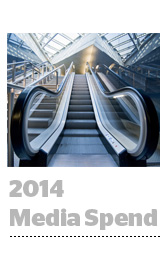 As agencies, media companies, and platform players converge on the south of France for the annual Cannes Lions festival, the overall state of their industry appears to be strong.
As agencies, media companies, and platform players converge on the south of France for the annual Cannes Lions festival, the overall state of their industry appears to be strong.
In its latest media spend forecast, Magna Global remains bullish on both total media owner advertising revenues and programmatic revenues. Meanwhile, total media spend will grow 6.4% to $516 billion in 2014. Of that growth nearly two thirds ($20 billion) will come in digital, especially social, video, and search.
Meanwhile, programmatic (both RTB and non-RTB) will reach $18.4 billion this year, about 3.5% of all ad spending. More than half of programmatic spend ($9.8 billion) will be in the US.
The overall projections are in line with the IPG Mediabrands’s media investment arm’s previous projection, but there are some significant revisions in the details.
RTB stays strong. A recurring theme of late has been the automation of non-RTB inventory, and some have speculated that time-shifted impression buying will quickly eclipse real-time bidding as the engine of programmatic momentum. Magna appears not to think so, at least not in the US. It believes US programmatic spend will grow from $9.8 billion in the U.S. in 2014 to $17 billion by 2017. At that late date, well over half ($10.5 billion) will still be traded on a real-time basis.
This is especially interesting coming from Magna because its parent IPG Mediabrands has been so aggressive on its own projections for non-RTB automation. The company has proposed to automate 50% of all media spend by the end of 2015.
Magna’s overall estimate for programmatic spend remains unchanged from last fall. It believes programmatic channels will draw $37.5 billion globally by 2017.
Some other key findings:
- TV: Television looks very strong in 2014 thanks to non-recurring sports events. The World Cup and the Olympics will boost the TV channel +7.2% this year, compared to +2.7% in 2013.
- Digital definition: Digital media continues to grow by double digits, and will add $20 billion in new spend globally this year. But most of that growth comes from social, video and search. Traditional display is flat or even declining in mature markets, Magna says. Meanwhile, mobile will grow by $10.3 billion this year to $27.1 billion on a global basis. That’s a growth rate of 61%, compared to 9% for non-mobile placements. That said, the distinction between “mobile” and “desktop” has come to seem artificial as the world goes cross-device.
- China in perspective: China may be an ad juggernaut in the making, having just surpassed Japan in 2013 to become the world’s second largest advertising market. But with ad revenues of $45 billion, it’s still only about 29% of the US ad market size.
- Country shifts: The report is largely consistent with its most recent revision in December 2014, forecasting ad spend growth of 6.4% reflecting global acceleration of the economic recovery (plus World Cup and the Olympics). However, there are a few devils in the details. For instance, the US, Canada and the UK will grow faster than previously thought, while China, Russia, Germany, France and Australia were all revised downward. “The economic recovery remains fragile in the Euro area and the Australian economy is faltering,” the report states.












